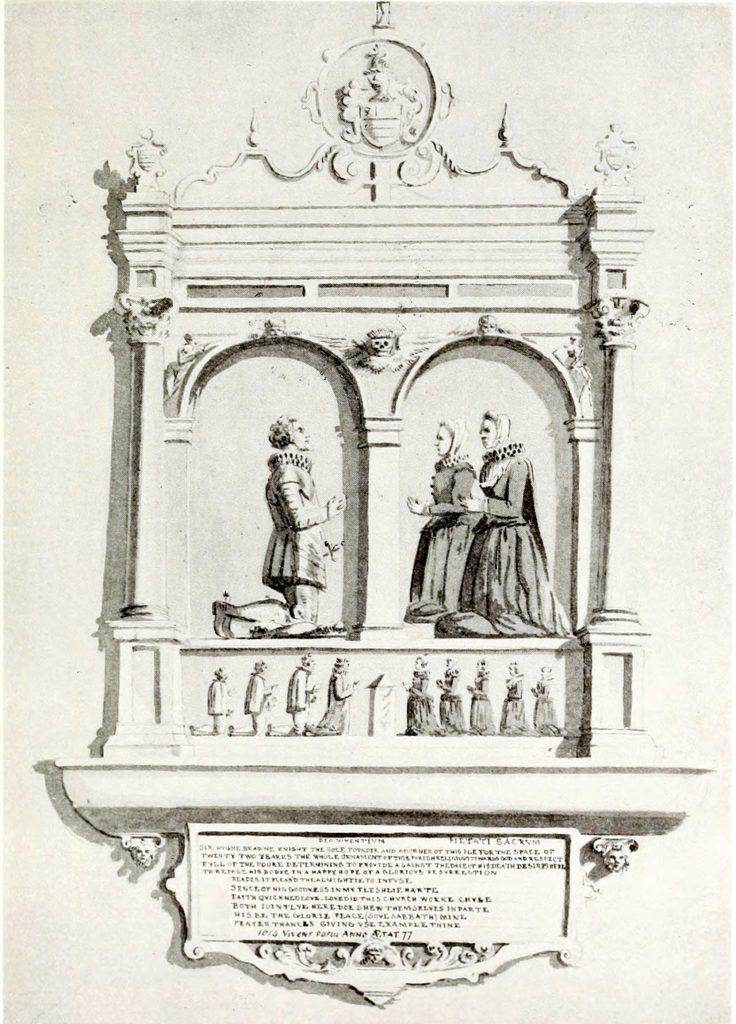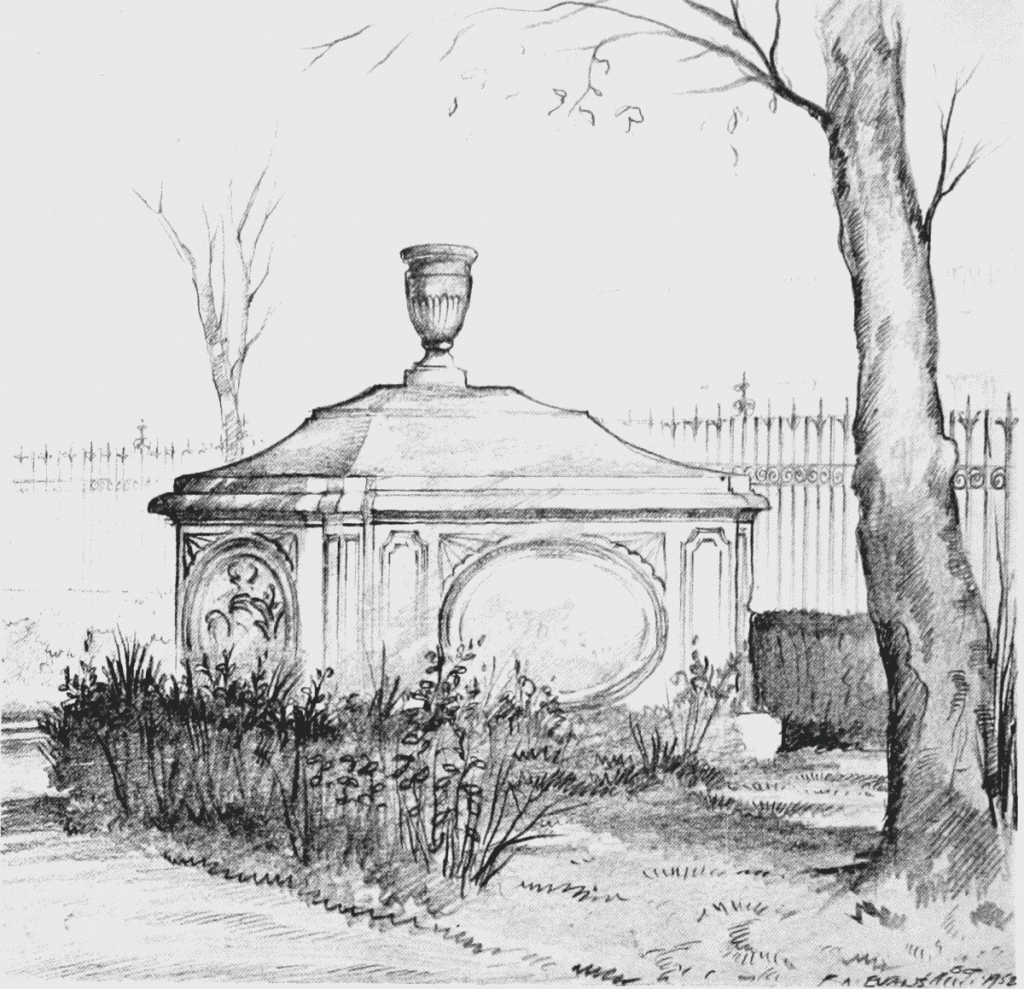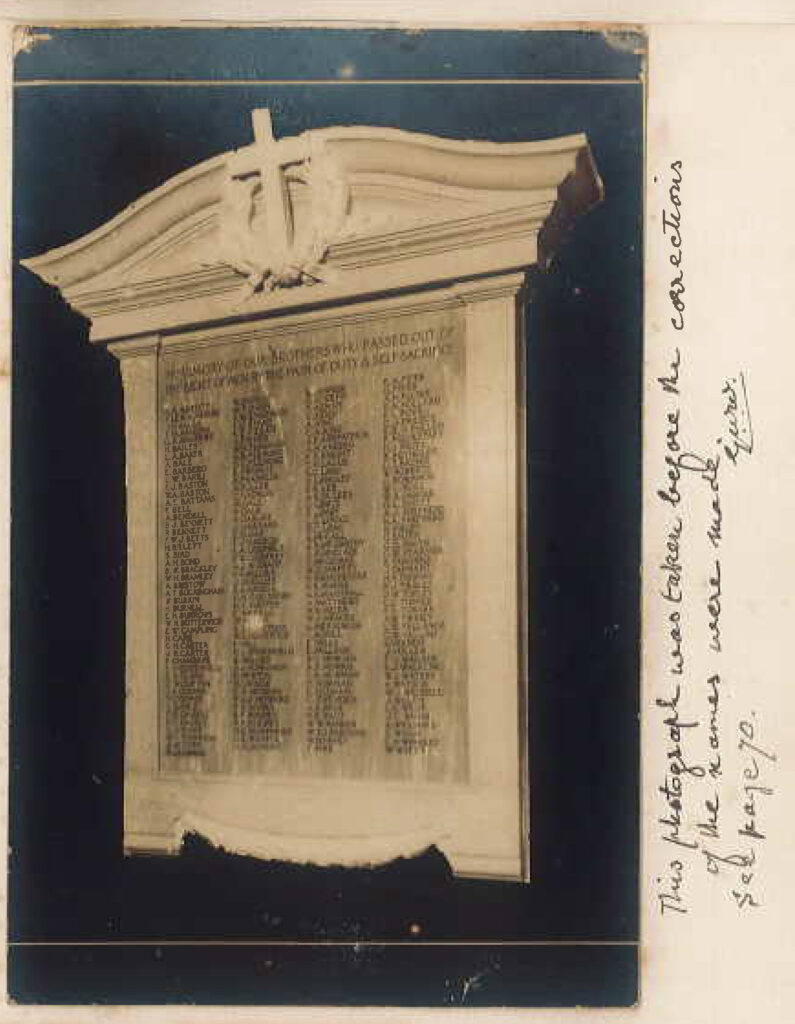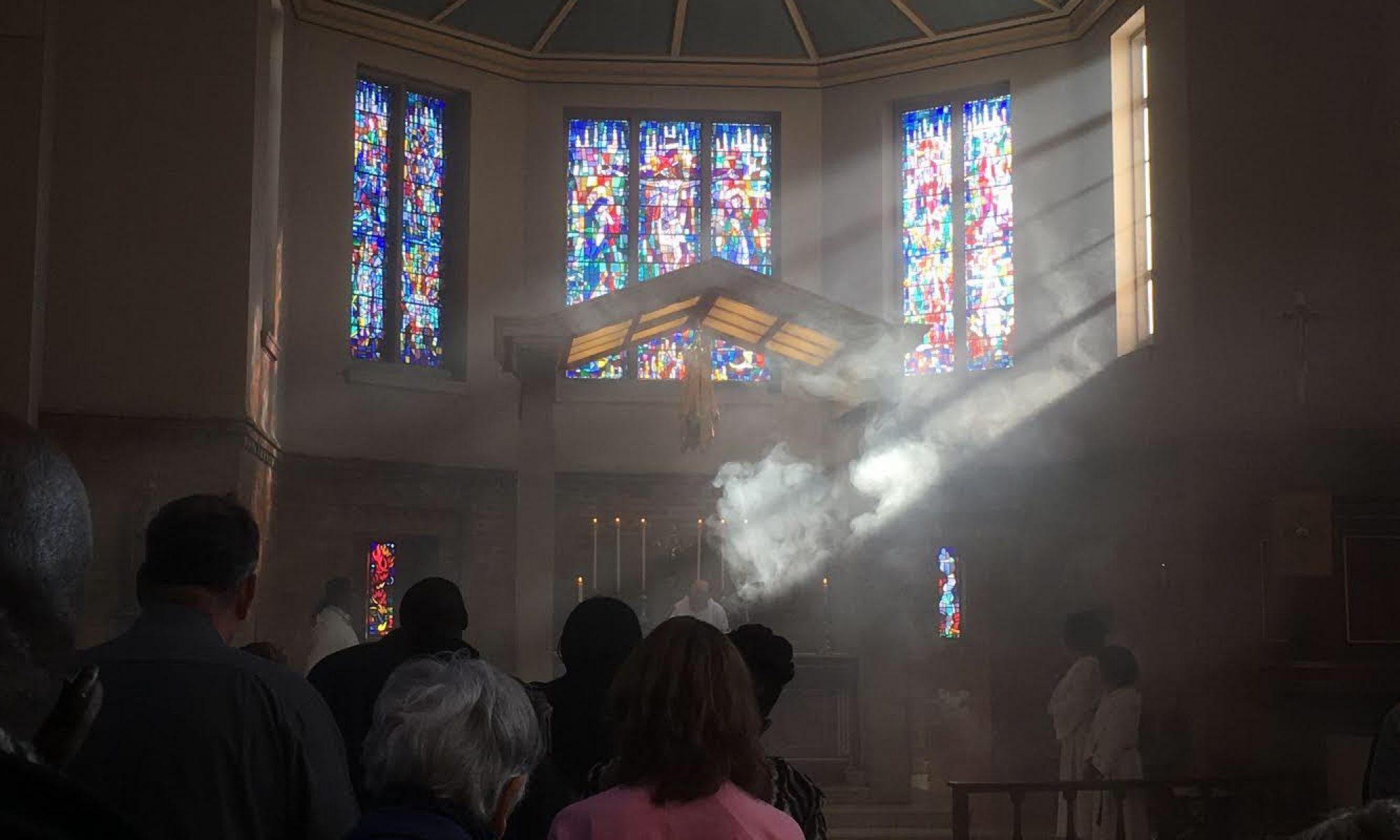The modern church has no graveyard or memorial plaques, though there is a small memorial garden on the north side of the church. From descriptions of the church before it was moved to the current site, we know of some of the people who lived in the parish and worshipped at St Mary’s.
Several late 18th century authors mention instances of longevity recorded in the parish Registers:
Edward Allen aged 107 years was buried on 20 January 1685
Sarah Wood, aged 101 was buried on 5th April 1701
Mary Ralf, aged 100 was buried on 5th April 1701
Christopher Coward, aged 102 was buried on 16 December 1703
Widow Jeweller, aged 106 was buried on 30 August 1706
CHURCH MONUMENTS AND TOMBS INSIDE THE CHURCH:
CHANCEL
Memorial plaques on the East Wall of the chancel.
A watercolour dated 1825, in the London Picture Archive, gives us a sense of how these were arranged to either side of the plaques show the Ten Commandments: London Picture Archive
James Reading and Mary his third wife, white marble inscribed commemorating their “exemplary peity towards God, integrity towards man, charity to the poor, and humility towards all, made them live desired, and dye lamented by all that knew them”. He died on 24 November 1694 aged 70. She, on the 9 August 1697, aged 62.
Bishop Horsley (one of the most eminent rectors of the parish), and his wife Sarah Horsley, who died on April 2 1805 aged 54; On the wall was a handsome monument of white marble, which was erected by the bishop, in memory of Sarah, who was his second wife, and had been the protégé of his first wife (Mary, daughter of the Rev. John Bothan, of Albury). The inscription recording her virtues is in Latin, and was written by Horsley. The plaque was ornamented with a sculpture of an open book, lying upon a mitre and crozier, with a cross above them. Beneath the first inscription was a second, written by the Rev. Heneage Horsley, A.M. (the bishop’s son by his first wife, and a canon of St. Asaph), commemorating the bishop himself, who aged 73, on the 4th October 1806. Bishop Horsley was interred with his wife, beneath the altar, at St Mary’s in 1806, having died in Brighton. When the church was taken down their coffins were found and moved with others to a vault.
Anthony Fothergill, M.D. F.R.S., a physician and medical writer of some eminence who died at an advanced age, in 1813, commemorated with an oval tablet
Charles de Guiffardiere, A.M., rector who died on January 1, 1810, aged ninety. His monument was white marble, at the upper part of which was an urn, with an extinguished torch, and an open book, inscribed:-
1. Ep. Pet. Cap. ii. Ver. 17–Deum timete, Regem honorate.
Juxta hoc marmor sepultus est Rev. Carolus de Guiffardiere, A.M.
hujusce parochiæ per sexdecim annos Rector.
Anicis semper deflendus, obit 1ma die Januarii,
anno Domini MDCCCXmo, ætatis suæ LXXmo.
Also in the chancel, though the exact position was not recorded
Richard Day, who died in 1784
and there were flat stones to the memory of
William Taswell, rector who died in 1731
Nathaniel Hough, D.D., rector who died in 1737
James Taswell, who died in 1710
James Tracy, Esq who died in 1773
Adam Hayes, Esq. one of Lord Anson’s companions in his voyage round the world, who died in 1785
NORTH AISLE
Monuments
Sir Hugh Brawne, who died in 1615. The monument was of Corinthian order, exhibiting small statues of Sir Hugh Brawne, his two wives, four sons, and six daughters, in devotional attitudes. He built the north aisle in the old church, which he chose for his burial-place; and “for the space of 22 years was the whole ornament of the parish”. The inscription read
Reader, it pleas’d the Almighty to infuse
Sence of his goodness in my fleshy heart:
Faith quciken’d Love; Love did his Church-work chuse,
Both jointly here to shew ourselves in part.
His be the glory; Peace (Soule’s Sabbath) mine;
Prayer, Thanksgiving, Use, Example, thine.
1614. Vivens posui, Anno ætatis 77.

Tombs
Mrs. Sarah Crawford, who died in 1766
Mrs. Martha Crawford, who died in 1786
NAVE
Against the pillars of the nave were the monuments of
Thomas Inwen, who died in 1743
Richard Boulton, who died in 1750
On the floor, flat stones to the memory of
Margaret wife of William Allen, of Antigua
George Powell, who died in 1704. The Editor of Aubrey’s Antiquities of Surrey says, that the latter was called “King of the Gipsies”, and that he died in very flourishing circumstances
SOUTH AISLE
Memorials
Captain Martin Waghorn, a naval officer. He was one of the few people who escaped from the Royal George, when that ship sunk, off Spithead, on 28 June 1782. He died on 17 December 1787, aged fifty-three years
Richard Saumarez, F.R.S. R.C.S., an eminent surgeon, and author of works on Physiology and other branches of medical science. He died in Bath aged 71 on 28th January 1835
WEST END
Tombs
William Davy, serjeant at law, who died in 1786. According to Edward Walford “He was originally a chemist at Exeter, and a sheriff’s officer coming to serve on him a process from the Court of Common Please, he civilly asked him if he would not take something to drink. While the man was leisurely quenching his thirst Davy contrived to heat the poker, and then told the bailiff that if he did not eat the write, which was of sheepskin, he should be made to swallow the poker. The officer very naturally preferred the parchment.” The Court of Common Pleas committed him to the Fleet Prison for contempt following this episode. On discharge from prison though, Mr Davy studied law and went on to be admitted to the bar where he had a successful practice.
Under the belfry was the tomb of
William Dale, surgeon, who died in 1718
CHURCH YARD

The church yard was enlarged by act of parliament 29 Geo. II (1756).
The most conspicuous monument there was that of William Allen, who was killed by the soldiers in St. George’s Fields in the year 1768. The inscription asserted that he was ‘inhumanly murdered on the 10th of May by Scottish detachments from the army.” There were also some verses and texts of scripture, which Daniel Lyson felt had been applied “with a very unjustifiable spirit of rancour, as an excuse for which it must be admitted that the monument was erected during the height of party rage, and in the first transports of resentment by parents who had lost an only son. The account of the riots which took place in St. George’s Fields in 1768, and the circumstances of this transaction are detailed in many of the publications of that time. It appears that Allen was illegally killed, whether he was concerned in the riots or not, as he was shot apart from the mob at a time when he might, if necessary, have been apprehended and brought to justice. The acquittal of the soldier who was tried for his murder, made a great clamour at the time, though it appears that the weight of evidence preponderated much in his favour, and proved to the satisfaction of the jury that he was not the person who fired the gun.”
SACRED/TO THE MEMORY OF
WILLIAM ALLEN
An Englishman of unspotted life and amiable
Disposition,
who was inhumanly Murdered near St. Mary’s
Fields on the 10th day of May 1768 by Scottish
Detachment from the Army,
His disconsolate Parents, inhabitants of this
Parish caused this Tomb to be erected to an only son
lost to them and to the world in his twentieth year
as a Monument of his virtues and their affection.
Another man buried in the churchyard was the Elizabethan playwright and poet Thomas Middleton who died in July 1627. He is said to have worked with Shakespeare on “Macbeth”, “Timon of Athens”, and “Measure for Measure” amongst other works. He died in poverty in the parish and was buried on 4 July, 1627. Middleton’s own “city comedies” mercilessly satirized the seamy side of London life, with its con artists and courtesans, rich widows and gold-digging would-be gentlemen. His biggest theatrical success was the political allegory “A Game at Chess”, performed by the King’s Men at The Globe in August 1624. At a time when London’s theatres put on a different play every day, Middleton’s satire was held over for nine consecutive performances—the first “long run” in English theatrical history.
Lyson also mentions the tombs of the following people in the church yard:
Mrs. Emblem Richardson, governess of a boarding school who died in 1743
William White, Gent. of the Inner Temple, who died in 1769
Capt. John Diddear, who died in 1773
Benjamin, son of Timothy Bennet, M.D. who died in 1773
Barnabas Mayor, fellow and one of the directors of the society of artists of Great Britain, who died in 1774
James Abernithy, Esq. who died in 1781
Reverend James Hassel, rector of North Rungton, Norfolk, who died in 1781
Leversidge Brandon, who died in 1785
Mary, relict of Captain Peter Guerin, who died in 1785
Sibella, wife of Benjamin Batley, Esq. who died in 1787
Elizabeth, wife of Captain Magnus Henderson, who died in 1790
Clarissa, wife of Captain Robert Rayne, in the military service of the East-India Company, who died in 1791
John Robson, Esq. who died in 1791

The London Picture Archive holds 2 watercolours dated c.1800
The first shows coats of arms on each end of a monument in the churchyard Newington Butts. The left coat of arms belongs to Joseph Hetherington Esq, 1792 and the right one belongs to John Robson Esq. 1791. London Picture Archive – Hetherington and Robson
The second Four coats of arms in Newington Butts, Southwark; starting clockwise from the top left they belong to Hugh Kennedy, Bannister family, Robert Pearce and Richardson family. London Picture Archive – Kennedy, Bannister, Pearce and Richardson
The older churchyard still exists as Newington Gardens though many of the tombstones have been removed. In 2007 Southwark Council re-landscaped the churchyard as part of the Elephant and Castle Regeneration scheme. Very little evidence of the old buildings remained but a few gravestones were found and placed along the side of Churchyard Row next to the listed railings, which were also restored, and the clock tower memorial stone. Some old vaults and burial plots were found during the work and these were recorded by an archaeologist and left undisturbed.
Notable local residents include
Michael Faraday, born in Newington Butts and baptised at St Mary’s in 1791.
George Alexander Gratton, who was brought to England from the island of St Vincent in 1870 and baptised in St Mary’s that same year. He had a skin disorder and was known as the Spotted Negro Boy. The poor boy was shown around London and its surroundings as a curiosity and sadly he died aged only 5 years old in Feburary 1813.
Maj. Robert E. Rogers, a colonial farmer, who was born in New Hampshire, USA and was recruited by the British during the Seven Years War. He formed a unit off Rangers (Rogers’ Rangers) in 1754 and by 1758 he was in charge of all colonial Range companies. Due to his expert woodmanship and aggressive nature in battle, his rangers were one of the few forces able to withstand, and flourish in, the harsh and frigid New England region. He spent much of his own money equipping his troops so when the Treaty of Paris was declared in 1763 he was deeply in debt. He was thrown into prison in New York but escaped to England where he became an author. King George III funded him to search for the North West Passage so he returned to America but he was arrested for treason, though later acquitted. After further adventures in the US he retired from military life back in England but did not prosper and died a debtor in Kings Bench Prison (near present-day Borough Road) and was buried in St Mary’s in an unmarked grave.
The Surrey Archaeological Collections Vol 11 (1893) p.123 records a will of
Margery Dobsonne, servant to Sir Hugh Brane, Knt., 6 November, 1608.
‘I Margerie Dobsonne s’vaunte to the right Worshipfull Sr Hughe Brane Knight.’
To be buried in Newington Churchyard. To Marie Egleston my extrix. servant to Sr Hughe Brane ‘one truncke and one chest being in them one moorrning gowne two petticoates two table cothes and two paire of fine sheetes being at maister William Smithes at the red Ivon in the Powltrey the trunck being full of lynnen with a fayer taffita apron’ with other goods at maister Marrites in Gutterlane ‘and maister Townsendes at Fleet bridge.’—
To Edward Corbat another servant 30s. Dat. 6 Nov. 1603.
Pd 2d Novr 1603 by Proctor to extrix. (P. C. C., Bolein, fo. 91.)
Lost World War One memorial in the Victorian church
In 1919 a committee was formed with the resolution to erect a Marble Tablet in the Parish Churchof St Mary with St Gabriel, Newington, in memory of those who had fallen in the War. The memorial was to be for all in the Ecclesiastical Parish who have fallen and for those not resident in the Parish whose names were submitted and approved by the parish authority set up for the purpose. The Young Men’s Clubs were to be permitted to go with their work for separate memorials. The names were to be recorded on a marble tablet and also in a book, kept in the church but sadly when the church was bombed during the Blitz the memorial was destroyed with the church. The original idea to have a book of the dead was not fulfilled due to financial constraints but a minute book of the committee with all the names can still be consulted at the church by arrangement with the Rector.
Names were submitted on a simple form which asked for the Names of the Sailor, Soldier or Airman; Their home address, their Regiment and Rank, Decorations and whether the name had been recorded at any other church which was delivered to every house in the parish together with an envelope for contributions towards costs. The majority of these forms were later stuck into the minute book of the presiding committee.
A service was held on Sunday May 1st 1921 when the Bishop of Kingston dedicated the memorial. It was designed and executed by Messrs. Bounds & Son, or Gaza Street an according to the Parish magazine “there seems to be universal satisfaction with it”. “It is remarkable for the simple dignity of the design and excellence of the workmanship” and the total cost was £156. The memorial was sited at the west end of the south wall of the church.

Historic photo of the tablet as it was when erected. Copyright reserved
Subsequently it was discovered that there had been a few errors and omissions and one man was listed who had survived the war. It is not clear from the book whether the corrections were made, other than deleting the living man, but the corrections are reflected in the list below.
Sources:
John Aubrey History of Surrey (1719)
Daniel Lyson Environs of London vol. 1, Surrey (1791)
Edward Wedlake Brayley Topgraphical History of Surrey (1850
Edward Walford Old and New London Vol. VI, ch XX (1878)
Minute Book of the War Memorial Committee
